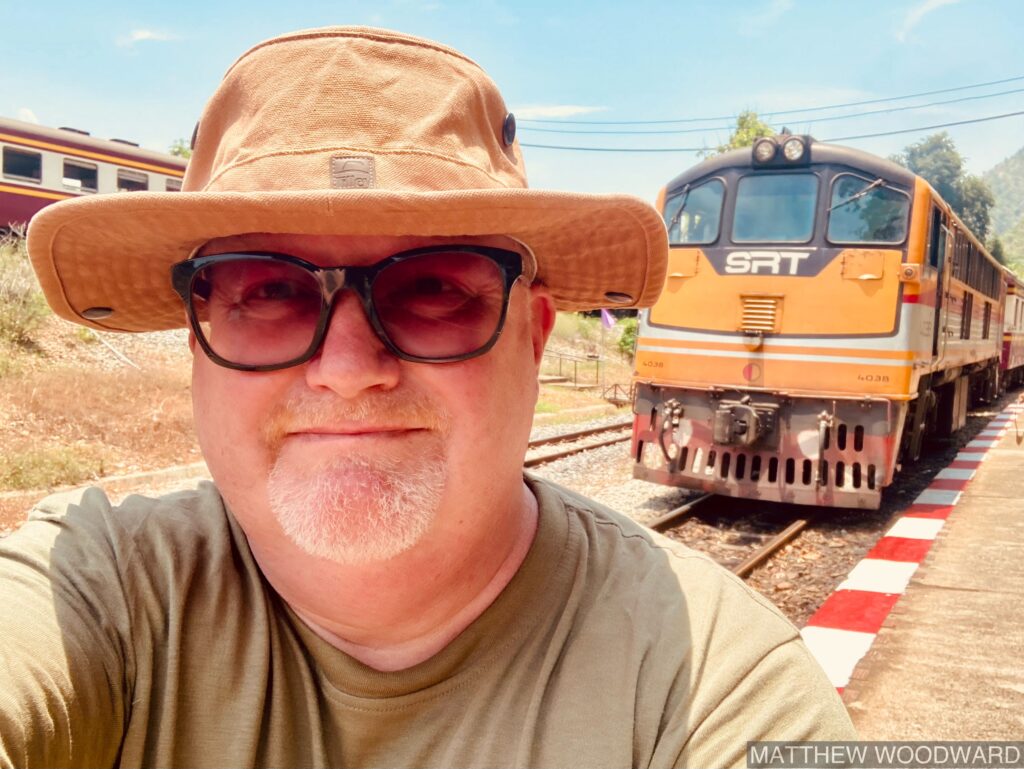Train 257 to Nam Tok

I’m going to be writing shorter blog posts whilst on this journey. I’m sorry about that, but as I’m discovering it’s hard to take notes for the book at the same time as blogging, photographing and posting on social media. It would be possible, but I like a little time to unwind at the end of the day with a couple of cold beers. I’m also going to save the stories of my ‘adventures’ for the book – the blogs will be more of a log book of my trips. I’m writing these on an iPad in a bit of haste, so please do try to overlook any lack of polish on my part from time to time.
My first mission on what I’m calling the ‘Siam Grand Tour’ is a gentle two day excursion from Bangkok up to Nam Tok in the direction of Myanmar. You might better know the upper part of this route as ‘The Death Railway’.
Today’s train departs not from Bang Sue or Hua Lamphong, but a lesser known station on the other side of the river called Thon Buri. I’ll update you on how the stations now all connect up in a later post, as it is fast changing at the moment.
It’s an early start, or a very late one depending on which hand of my GMT watch I choose to follow. I’m at the station nice and early to buy a ticket before departure at 07.45. Tickets on this line cost more for foreigners than locals, but it still only costs 100 Baht or about £2.50 for the four hour trip up to the end of the present day line at Nam Tok. Further up country from here is Hellfire Pass, the preserved remains of the Burma Railway made infamous in books like ‘The Railway Man’ by Eric Lomax.
We set off on time, and the journey is mostly pleasant, but in my eagerness to get back on the rails in Thailand I have not consulted my weather atlas. It’s the hot season (soon to be the hot and wet season) and the temperature is a sapping 38C in the shade with high humidity in the middle part of the day. In the 3rd class carriages fans whir on the ceiling, but best of all the windows and doors are open so the dry and dusty air is forced through keeping the sweat largely at bay.
The suburbs and shanty settlements on the outskirts of Bangkok eventually give way to fertile countryside after passing through the last big town of Nakhon Pathom. Two and a half hours after leaving Bangkok we cross the current bridge at Saphan Kwae Yai (River Kwae) and skirt the mountains that separate Thailand from Myanmar. The train chugs across rickety wooden supported bridges above the river. It’s all very scenic and pleasure to stare out the window.
I’ll write about the Burma railway and Hellfire Pass in another post, but after Nam Tok, I headed back to the bridge on thee Kwai to spend a day exploring. I wrote about this a few years ago in a book called ‘A Bridge Even Further’. The place is not quite what it should be. Crowds of tourists buy souvenirs and pose for selfies with waxworks of prisoners of war. I suspect they have a limited understanding of what went on here. To my horror a new restaurant and themed attraction has opened up on the far bank just where the wooden bridge would have been. It’s called ‘Prisoner of War Camp’.
Anyway, after finding a place to stay, and after a couple of life saving cold beers and I went out like a light, waking eight hours later to the squark of exotic birds and insects outside my room.
The train back to Bangkok (train 258) had a few travellers on board, but mainly locals. The single line slowed us down as we had to wait for trains in the other direction at several station stops, but eventually we arrived back into the city slightly late, at around 18.00.
This journey is easy to do, tickets don’t need to be bought until the day of travel, and there are plenty of places to stay around the tourist area of Kanchanaburi. I’d highly recommend it, and much more fun than one of the ubiquitous bus tours.
A couple of days in Bangkok before the next leg of the Siam Grand Tour..




